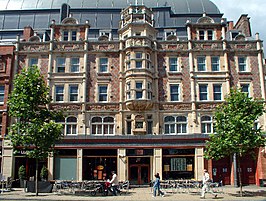
Back Kroydon Azerbaijani کرویدون AZB Кройдън Bulgarian Croydon Catalan Croydon (Londýn) Czech Croydon Welsh Croydon German کرویدون Persian Croydon French Croydon Irish
| Croydon | |
|---|---|
|
Clockwise from top: the Old Town Hall and Clocktower (with the Spreadeagle in the foreground), Katharine Street; No. 1 Croydon building; the Grants Building, High Street; Saffron Square and other blocks | |
Location within Greater London | |
| Population | 192,064 (2011 Census)[1] |
| OS grid reference | TQ335655 |
| • Charing Cross | 9.3 mi (15.0 km) N |
| London borough | |
| Ceremonial county | Greater London |
| Region | |
| Country | England |
| Sovereign state | United Kingdom |
| Post town | CROYDON |
| Postcode district | CR0 |
| Dialling code | 020 01689 (Addington and New Addington parts) |
| Police | Metropolitan |
| Fire | London |
| Ambulance | London |
| UK Parliament | |
| London Assembly | |
Croydon is a large town in South London, England, 9.3 miles (15.0 km) south of Charing Cross. Part of the London Borough of Croydon, a local government district of Greater London, it is one of the largest commercial districts in Greater London, with an extensive shopping district.[2] The entire town[3] had a population of 192,064 as of 2011, whilst the wider borough had a population of 384,837.
Historically an ancient parish in the Wallington hundred of Surrey, at the time of the Norman conquest of England Croydon had a church, a mill, and around 365 inhabitants, as recorded in the Domesday Book of 1086. Croydon expanded in the Middle Ages as a market town and a centre for charcoal production, leather tanning and brewing. The brewing industry remaining strong for hundreds of years.[4] The Surrey Iron Railway from Croydon to Wandsworth opened in 1803 and was an early public railway. Later 19th century railway building facilitated Croydon's growth as a commuter town for London. By the early 20th century, Croydon was an important industrial area, known for car manufacture, metal working and Croydon Airport. In the mid 20th century these sectors were replaced by retailing and the service economy, brought about by massive redevelopment which saw the rise of office blocks and the Whitgift Centre, the largest shopping centre in Greater London until 2008. Historically, the town formed part of the County of Surrey, and between 1889 and 1965 a county borough, but was amalgamated into Greater London in 1965.
Croydon lies on a transport corridor between central London and the south coast of England, to the north of two high gaps in the North Downs, one taken by the A23 Brighton Road and the main railway line through Purley and Merstham and the other by the A22 from Purley to the M25 Godstone interchange. Road traffic is diverted away from a largely pedestrianised town centre, mostly consisting of North End. East Croydon railway station is a hub of the national railway system, with frequent fast services to central London, Brighton and the south coast. The town is also at the centre of the only tramway system in southern England.
- ^ Croydon is made up of 13 wards in the London Borough of Croydon: Addiscombe, Ashburton, Broad Green, Croham, Fairfield, Fieldway, Heathfield, New Addington, Sanderstead, Selhurst, Selsdon and Ballards, Shirley, and Waddon. "2011 Census Ward Population Estimates | London DataStore". Archived from the original on 22 February 2014. Retrieved 9 June 2014.
- ^ Mayor of London (February 2008). "London Plan (Consolidated with Alterations since 2004)" (PDF). Greater London Authority. Archived from the original (PDF) on 2 June 2010. Retrieved 21 December 2013.
- ^ Including South Croydon and Selhurst
- ^ Shaw, Herbert. "A Croydon Brewery" (PDF). Journal of the Brewery History Society.
© MMXXIII Rich X Search. We shall prevail. All rights reserved. Rich X Search




